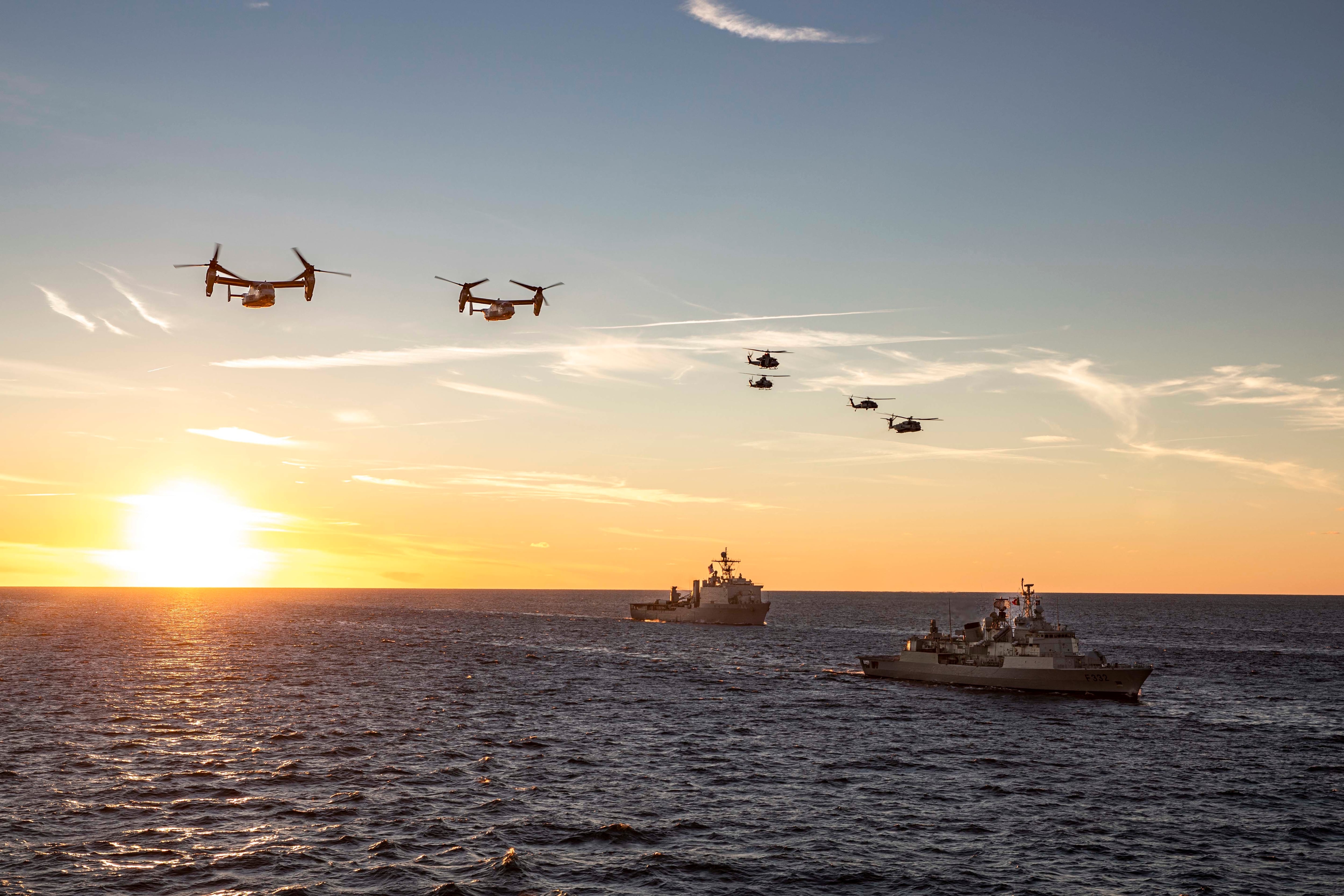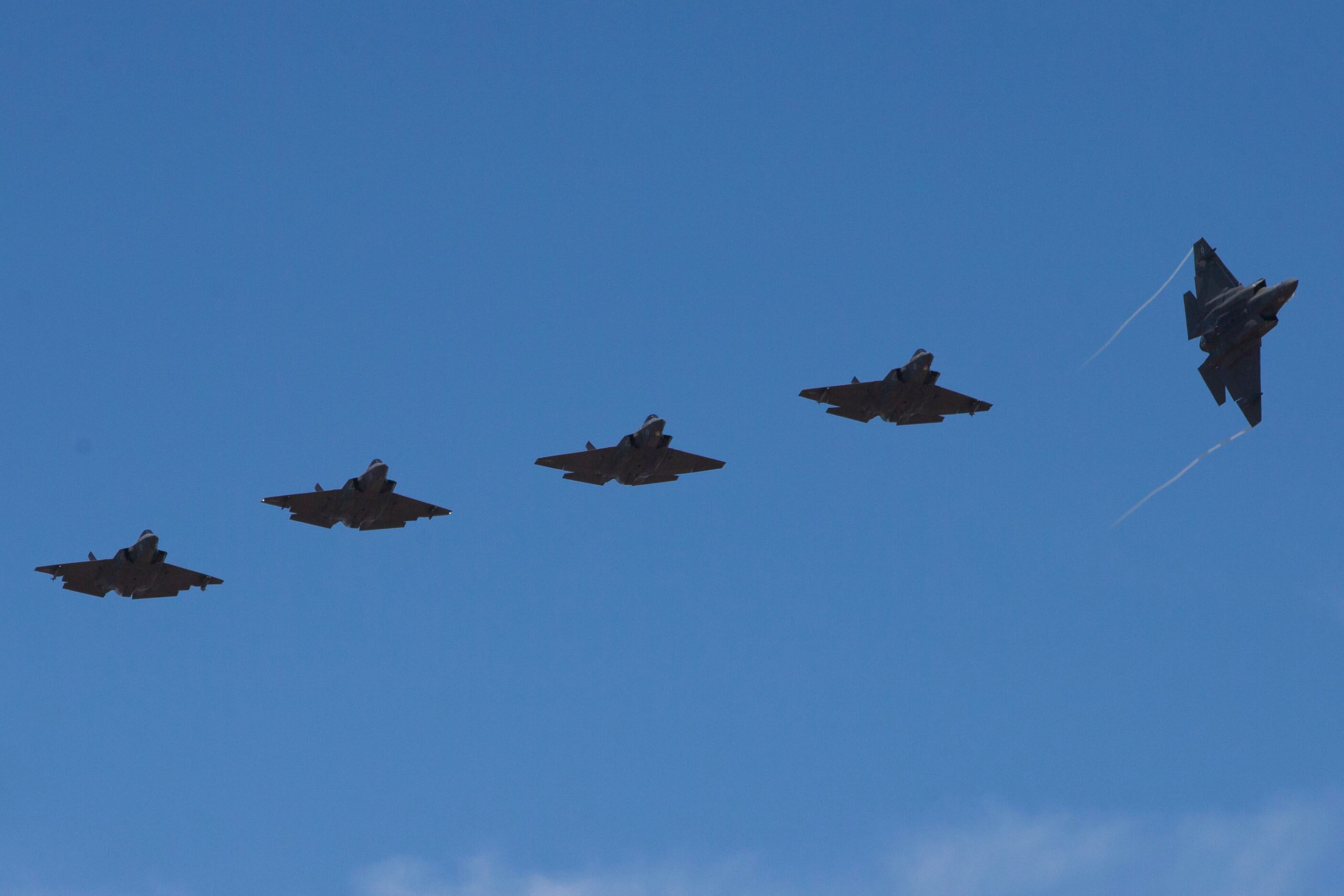WASHINGTON — The Navy and Marine Corps’ fiscal 2024 budget request would invest in long-range missiles and the platforms that shoot them — surface combatants, fighter jets and nimble Marine Corps units — while slashing the amphibious ship fleet.
Department officials say the $255.8 billion request matches Chief of Naval Operations’ Adm. Mike Gilday’s effort to prioritize readiness over the size of the force. The budget is up $11 billion, or 4.5%, from what Congress enacted for FY23.
The proposal would fund nine ships and 88 aircraft and kick off multiyear procurement for four long-range weapons: the Standard Missile, the Naval Strike Missile, the Long-Range Anti-Ship Missile and the Advanced Medium-Range Air-to-Air Missile.
Its readiness spending would include funding private and public shipyard repairs at 100% of the planned requirement — an increase of $1.9 billion, or about 15%, compared to FY23 spending on ship maintenance, to pay for 75 ship availabilities — and a “significant investment” of $541 million for spare parts for the Virginia-class submarines, according to Rear Adm. John Gumbleton, the deputy assistant secretary of the Navy for budget and director of fiscal management.
The service is seeking $2.73 billion, 47% more than FY23, for the Shipyard Infrastructure Optimization Program, meant to recapitalize, modernize and boost the efficiency of the Navy’s four public shipyards.
The budget requests also highlights the Indo-Pacific region and Europe as priority areas and directs money toward increased operations and base infrastructure there. The Navy seeks $3.2 billion for the Pentagon’s Pacific Deterrence Initiative and $129 million for the European Deterrence Initiative.
A steady shipbuilding profile
The Navy requests $32.8 billion in shipbuilding procurement to buy nine ships, one more than it asked for in FY23. However, Congress added three to last year’s request, for a total of 11.
The Navy’s budget proposal pays for the second Columbia-class ballistic missile submarine, as the program accelerates production to prepare for a one-a-year rate in FY26.
It also includes two Virginia-class attack submarines, two Arleigh Burke-class destroyers, two Constellation-class frigates, one John Lewis-class oiler, and one submarine tender.
This request matches planned procurement rates for the submarines and surface combatants. The Navy proposes keeping the Virginias and Arleigh Burkes at a stable two-per-year procurement rate.
The service is buying Constellation frigates in a “sawtooth” profile, alternating between one and two a year until the Navy is ready to bump shipbuilder Fincantieri up to a stable two-a-year rate.
The FY24 plan slows the oiler program — the Navy previously expected to buy two in FY24 instead of one — and accelerates the start of the new sub tender program by a year.
The Navy’s plan also includes $1.9 billion for the Ford-class carrier program, as part of the incremental funding of a two-ship contract awarded in FY19, as well as $1.8 billion for the final payment on an America-class amphibious assault ship. It also buys two used sealift vessels as part of an ongoing recapitalization effort.

Absent from the request is any funding for amphibious ships. The Navy announced in its FY23 request it would truncate the San Antonio-class amphibious transport dock production line.
The service said it would use this “strategic pause” to reevaluate the design it wants when it resumes buying these medium-sized amphibious ships — though, according to the FY24 plan, that wouldn’t happen within the next five years.
The budget proposal, however, accelerates the procurement of the next America-class amphibious assault ship. The last ship, LHA-9, was procured in FY21, according to the Congressional Research Service’s accounting of the ship, which was purchased over multiple years.
The Navy last year said it wouldn’t buy LHA-10 until FY31, but the Navy’s FY24 budget request indicates LHA-10 is set for a FY27 procurement.
The plan would also decommission three Whidbey Island-class amphibious dock landing ships ahead of their planned end of service life, along with three Ticonderoga-class cruisers and two Independence-variant littoral combat ships.
‘Massive investment’ in weapons
The Navy’s weapons procurement budget includes two significant items: the first procurement of the Conventional Prompt Strike hypersonic missile, and the kickoff of four multiyear procurement efforts for long-range missiles.
The Navy plans to buy eight CPS missiles, which has until now been included in the research and development portfolio since 2019. Even as the Army will field its first missile batteries this fiscal year, the Navy is buying its own missiles ahead of the FY25 integration of the missile and new launcher onto the Zumwalt-class destroyer.
The budget also proposes five-year contracts with Lockheed Martin for the Long-Range Anti-Ship Missile and with Raytheon Technologies for the Standard Missile, Naval Strike Missile and Advanced Medium-Range Air-to-Air Missile.
The FY24 plan doesn’t call for a big jump in the quantity of these missiles: the Navy will again buy 125 Standard Missiles, consistent with recent years; the Navy and Marines will buy a combined 103 Naval Strike Missiles compared to 154 in FY23; the Navy wants 81 LRASMs compared to 58 in FY23; and it wants 374 AMRAAMs compared to 337 in FY23.
But the service does intend to invest in the weapons industrial base, with $380 million to expand construction facilities and increase overall capacity. In all, the Navy is asking to increase its weapons spending by about $2 billion over FY23, for a total of $6.9 billion in spending.

The Navy is also pausing its procurement of new Tactical Tomahawk missiles for the year but is investing in putting 274 missiles through a recertification and upgrade process and 472 through a navigation and communications upgrade. That’s a 65% increase and 72% increase, respectively, in how many missiles it plans to upgrade compared to FY23.
Gumbleton told reporters ahead of the budget release the Navy is making a “massive investment” in the weapons meant to create an “undeniable advantage” in the Pacific.
“Together with the Marine Corps, the Navy and our [foreign military sales], we are maxing out the lines with respect to Tomahawk and three of the four multiyear procurements, with the exception of the Naval Strike Missile,” he said.
The service is also eyeing an increase in the procurement rate of its Mk 48 heavyweight torpedo, asking for 71, compared to 28 in FY23.
Continued fighter, helo buys
The Department of the Navy’s FY24 budget seeks $17.3 billion for 88 fighters, helicopters, unmanned aircraft and training aircraft.
It would keep the F-35 production line at a stable rate, seeking 15 F-35C carrier variant jets for the Navy, four F-35Cs for the Marine Corps, and 16 F-35B vertical landing variant jets for the Marines.

It also would continue CH-53K heavy lift helicopter procurement for the Marines, asking for 15 in FY24 ahead of a planned rate increase starting the following year.
The budget seeks ramped-up production of the Multi-Engine Training System for the Navy and Marine Corps. This system is the trainer for aircraft including the V-22 Osprey variants, the E-2D Advanced Hawkeye, C-130 variants and the P-8A Poseidon. The Navy wants 14 of these, compared to six in FY23, and the Marine Corps wants 12, up from four the previous year.
The budget would also increase procurement of the MQ-25A Stingray unmanned aerial tanker, which the Navy is buying as a refueler for its carrier air wing. After purchasing the first system in FY23, the sea service is asking for three more in FY24.
Three programs will be funded for the last time in this budget: the Marines are buying the final two KC-130J cargo and tanker planes, the Navy is procuring its last two MQ-4C Triton unmanned aircraft, and the Marines are buying the last five MQ-9A unmanned planes.
Marine Corps reforms
The budget requests funding for several ongoing Marine Corps initiatives, including the Force Design 2030 modernization effort and the related Talent Management 2030 personnel reform effort.
Under Force Design, the FY24 request includes $16.9 billion for equipment modernization. This includes $6.55 billion for logistics systems, transportation and prepositioning; $5.65 billion for manned and unmanned platforms that can sense and detect; $1.37 billion for communication paths in garrison and in the field; $971 million for air- and ground-launched fires; $864 million for defenses against air, ground and electronic attack; $478 million for data integration, analysis and dissemination; and $201 million for data fusion for planning and command and control.
The plan also directs $343 million to Talent Management reforms, including $232 million for recruiting and retention.
Talent Management is meant to shape the corps into an older and more experienced force, a divergence from the way the Marine Corps has operated. The corps generally lets go about 75% of Marines after their first contract ends, the service has said, but now wants to invest in these Marines’ continued careers to support new operational plans.
Megan Eckstein is the naval warfare reporter at Defense News. She has covered military news since 2009, with a focus on U.S. Navy and Marine Corps operations, acquisition programs and budgets. She has reported from four geographic fleets and is happiest when she’s filing stories from a ship. Megan is a University of Maryland alumna.





